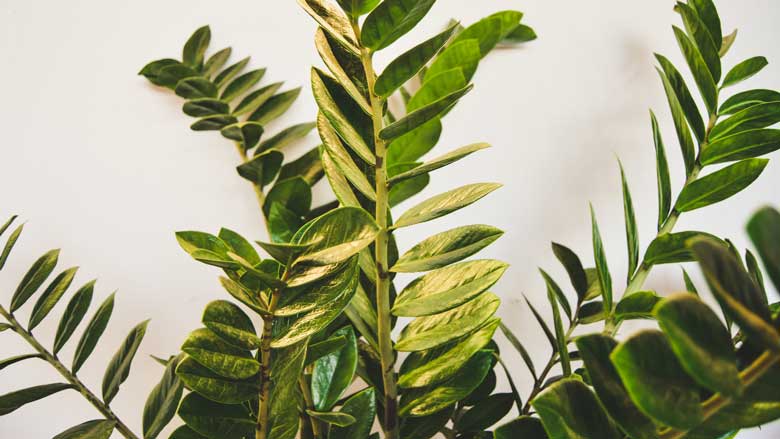Yellow leaves on ZZ plants often indicate overwatering, underwatering, insufficient light, excessive sunlight, nutrient deficiency, pest infestation, disease, temperature stress, transplant shock, or natural aging. Adjusting care, like watering, light exposure, or repotting, can often remedy this.
Zamioculcas zamiifolia originates from Eastern Africa and is widely known as the Zanzibar gem or ZZ Plant.
This tropical evergreen perennial can reach up to 1.5 meters (5 feet) in height and is characterized by its long, glossy, leathery leaves.
Its popularity as a houseplant stems from its minimal care needs and ability to thrive in low-light conditions.
A frequent issue faced by ZZ plants is the yellowing of leaves.
This problem can stem from various factors, yet numerous solutions are available to address it.
Reasons and Solutions for Yellow Leaves in ZZ Plants
ZZ plants (Zamioculcas zamiifolia) are known for being tough, drought-resistant, and low-maintenance.
However, even the most resilient plants can experience problems from time to time – like yellowing leaves.
While it’s not usually a cause for alarm, it can be frustrating to see your beautiful plant start to lose its color.
By understanding why ZZ plant leaves turn yellow, you can take the necessary steps to return your plant to its vibrant self in no time!
Here are 10 possible causes of yellow leaves on ZZ plants, along with solutions to fix the problem:
1. Overwatering
The primary reason for yellowing leaves in ZZ plants is excessive watering.
Originating from Africa’s arid regions, these plants have adapted to thrive in dry conditions.
Consequently, frequent watering leads to waterlogged roots, causing root rot. This issue manifests as yellow leaves, which may ultimately fall off.
Remedies for Overwatering
If you think your ZZ plant is getting too much water, the best solution is to stop watering it for a while and let the soil dry.
It is better to underwater a ZZ plant than to overwater it.
Once the soil has dried out, you can resume watering as usual.
ZZ plants need to be watered when the top inch of the soil is dry.
2. Underwatering
ZZ plants are native to arid regions of Africa, so they’re used to long periods without water.
When grown as houseplants, they need much less water than other common houseplants.
However, they still need some water to stay healthy. If you don’t water your ZZ plant regularly, the leaves will turn yellow and eventually drop off.
Remedies for Underwatering
If your ZZ plant is not getting enough water, the best solution is to water it more regularly.
ZZ plants need to be watered about once a week or when the top inch of soil is dry.
Water the plant until the water starts to drain out of the bottom of the pot.
3. Insufficient Light
ZZ plants are celebrated for their lush, green foliage.
However, these leaves can turn yellow when deprived of sufficient light.
The yellowing occurs as the plant struggles to produce chlorophyll, a key component for photosynthesis.
While ZZ plants are resilient in low-light environments, they falter in complete darkness and require bright, indirect light to flourish.
Enhancing Light Conditions
To ensure your ZZ plant receives adequate light, consider relocating it to a more luminous area.
These plants thrive best in bright, indirect light.
An ideal indoor spot is near a window with ample indirect sunlight.
Windows facing either west or east are preferable, providing the optimal balance of light for these plants.
4. Excessive Sunlight
ZZ plant leaves turn yellow when they get too much sunlight.
ZZ plants are native to Africa, where they grow in shady areas.
As a result, they are not used to direct sunlight and can quickly become sunburned.
The foliage will turn yellow due to sun damage, and eventually, the Zz plant leaves will start to fall off.
Managing Sunlight Exposure
Moving it to a shadier location is best if your ZZ plant is getting too much sunlight.
When growing ZZ plants indoors, place them near a window where they will receive plenty of indirect sunlight.
A west- or east-facing window is ideal, as it will give the plant plenty of light without exposing it to direct sunlight.
5. Nutrient Deficiency
Yellowing leaves in ZZ plants often indicate a nutrient deficiency.
While these plants are resilient in low light and minimal water, they still require essential nutrients to maintain health.
A lack of proper nutrition leads to losing their characteristic vibrant green color, resulting in yellow leaves.
This issue can arise from factors such as suboptimal soil quality, inadequate fertilizer application, or the use of nutrient-poor water.
Correcting Nutrient Deficiencies
To remedy this, regular fertilization is crucial. Utilize a balanced liquid fertilizer specifically designed for houseplants, applying it monthly during the plant’s active growth phase.
Additionally, incorporating a slow-release fertilizer into the potting mix when repotting can provide sustained nutrition.
For watering, opt for filtered or distilled water. This practice helps prevent the accumulation of excess chlorine or minerals in the soil, which could further stress the plant.
6. Pest Infestation
Yellowing leaves on your ZZ plant can also signify pest infestation.
Aphids, mealybugs, spider mites, and other pests are attracted to the plant’s sap, which can cause yellowing.
ZZ plant yellow leaves result from the damage the pests cause as they feed on the plant.
Pest Control Strategies
If your ZZ plant is infested with pests, treating it with insecticidal soap or neem oil is best.
You can also try wiping the leaves down with a cotton ball dipped in rubbing alcohol.
Be sure to check the plant regularly for pests and treat it as soon as you see any.
If the infestation is severe, you may need to throw away the plant and start with a new one.
7. Plant Diseases
Yellowing leaves on your ZZ plant can also be a sign of disease.
One of the most common diseases that affect ZZ plants is root rot.
Root rot is caused by too much moisture in the soil, resulting from overwatering or poorly draining potting soil.
The plant’s roots will start to rot and won’t be able to absorb the nutrients the plant needs.
As a result, the leaves will turn yellow and eventually drop off.
Disease Treatment
If your ZZ plant suffers from root rot, the best solution is to repot it in a fresh, well-draining potting mix.
First, remove the plant from its pot and check the roots. They will need to be trimmed away if they are soft or mushy.
Once you have removed the affected roots, repot the plant in a new pot with fresh soil.
Be sure to water it only when the potting soil mix is dry to avoid overwatering.
8. Temperature Stress
Temperature stress can also cause ZZ plant yellowing.
ZZ plants are tropical plants and prefer warm, humid conditions.
If the plant is exposed to cold temperatures, it will experience stress.
The leaves will turn yellow due to the stress and eventually die.
ZZ plants must be kept above 50 degrees Fahrenheit to avoid stress.
Also, temperature fluctuations can cause stress, so keeping the plant in a stable environment is essential.
Adjusting Temperatures
If your ZZ plant is experiencing temperature stress, moving it to a warmer location is best.
A south- or west-facing window is ideal, providing the plant with enough light and warmth.
You can also use a grow light to give the plant the additional light it needs.
Provide the plant with a consistent environment by avoiding drafts and fluctuating temperatures.
9. Transplant Shock
Transplant shock can also cause ZZ plant yellowing.
When a plant is transplanted, it goes through a lot of stress. The roots are disturbed, and the plant must adjust to a new pot and potting mix.
It’s not uncommon for the leaves of a plant to turn yellow after transplanting.
The good news is that transplant shock is usually temporary, and the leaves will eventually return to their normal color.
Mitigating Shock
If your ZZ plant is experiencing transplant shock, giving it time to recover is the best solution.
Keep the plant in a warm, sunny location and water it only when the potting mix is dry.
Avoid fertilizing the plant during this time, as it cannot absorb the nutrients.
You can resume your regular care routine once the leaves start to green up again.
10. Age-Related Yellowing
Finally, it’s important to remember that some ZZ plants will naturally have yellow leaves.
This is especially true of older plants, as the leaves will turn yellow and die off as the plant matures.
If your ZZ plant is otherwise healthy, there is no need to worry about this natural process.
Managing Natural Aging
If your ZZ plant is naturally yellowing, the best solution is to accept it.
You can remove the yellow leaves as they die off, but there is no need to try to fix the problem.
The plant will continue to produce new leaves that will be green and healthy.
Yellowing Leaves After Repotting a ZZ Plant: Causes and Solutions
Experiencing yellow leaves in a ZZ plant after repotting is a common occurrence and is typically a response to the stress caused by a change in its environment.
It’s essential to allow your plant time to adapt to alleviate this issue.
Ensure that the plant is adequately watered and placed in a well-lit area.
The leaves should gradually revert to their usual color with proper plant care.
ZZ Plant Yellow and Brown Leaves: Diagnosis and Treatment
Yellow and brown leaves in ZZ plants often indicate overwatering or excessive direct sunlight.
Overwatering deprives leaves of oxygen, turning them yellow and brown, while direct sunlight can lead to brown leaves due to sunburn.
To address overwatering, allow the soil to completely dry before watering again.
For plants exposed to direct sunlight, relocate them to an area with indirect light.
Other factors can also cause discoloration in ZZ plants:
- Yellowing and browning from the tips suggest over-fertilization.
- If the discoloration starts from the bottom, it might be a nutrient deficiency.
- A uniform yellowing and browning could indicate pest infestation.
Effective treatment involves identifying the specific cause and applying the corresponding remedy.
Should You Remove Yellow Leaves From a ZZ Plant?
ZZ plant yellow leaves should be removed to keep the plant healthy.
The plant uses these leaves to store water and nutrients, so it is not getting the resources it needs when it turns yellow.
Additionally, yellow leaves can be a sign of disease or pest infestation, so it is important to remove them to prevent the problem from spreading.
However, if the plant is otherwise healthy and the yellow leaves are not causing problems, they can be left on it.
Can Yellow Leaves Regain Their Green Color?
Yellow leaves on a ZZ plant are irreversible and will not regain their green color.
Once leaves become yellow, their ability to photosynthesize and produce chlorophyll ceases.
However, addressing the underlying issue causing the yellowing can lead to the growth of new, healthy green leaves.
Final Thoughts
Zamioculcas zamiifolia, commonly known as the ZZ plant, can have yellow leaves for various reasons. However, there’s no need to worry, as plenty of solutions exist!
Over or under-watering is a common issue. Adjust your watering routine to see if it helps. Light is another factor; if your plant lacks sufficient light, consider relocating it to a brighter area.
A nutrient deficiency might also be the culprit, so fertilizing the plant could be beneficial.
You’ll likely pinpoint the issue with some experimentation and quickly restore your ZZ plant’s vibrant green foliage.







